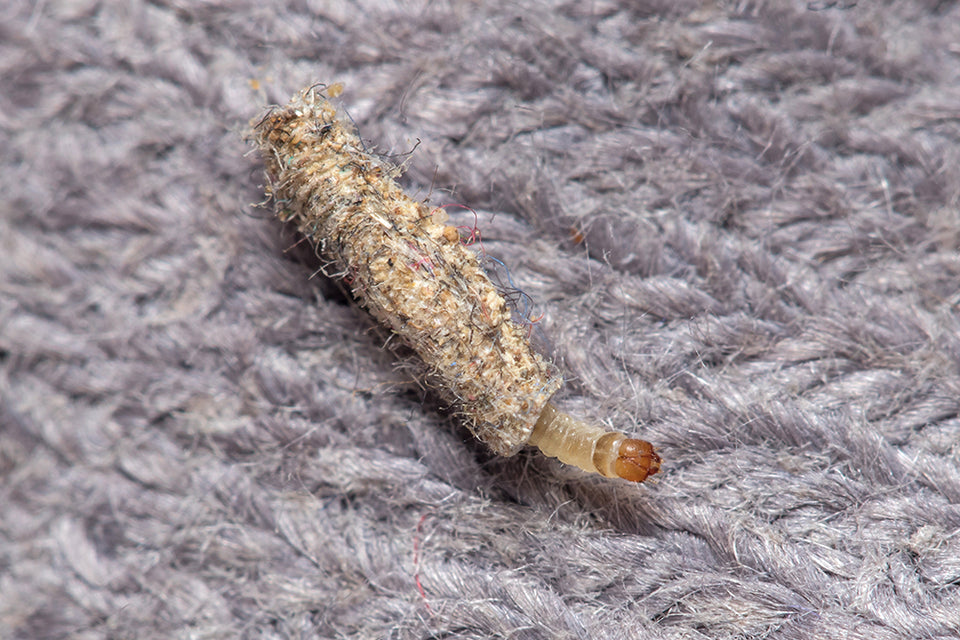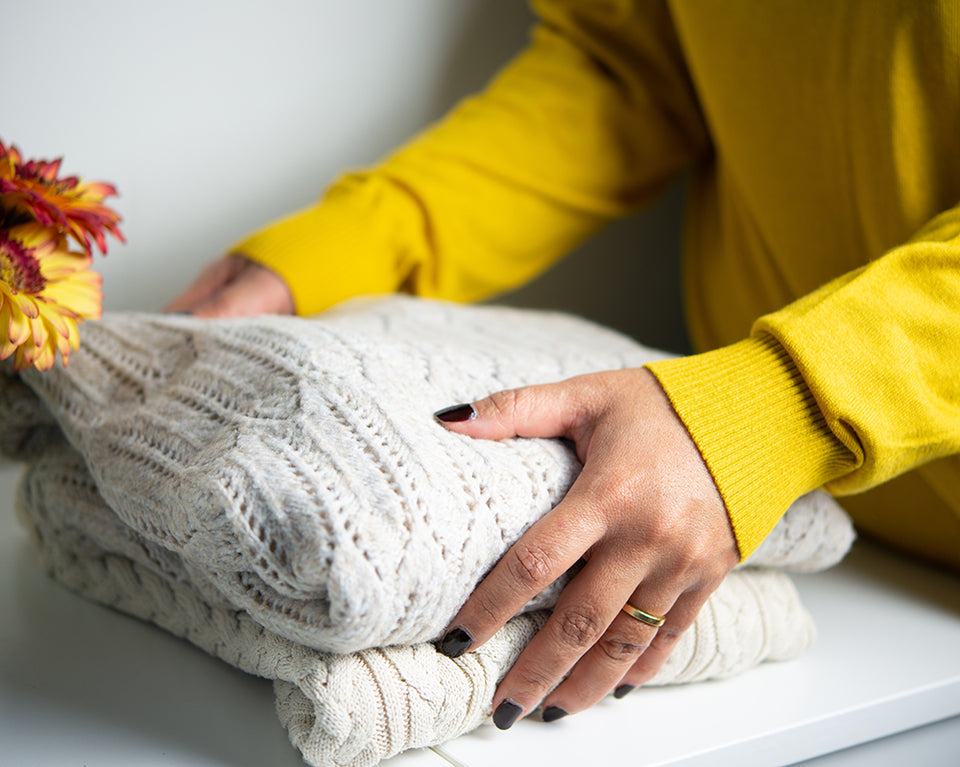What Causes Holes in Clothes?

Have you ever opened up your closet to select a favorite sweater and noticed that it was riddled with little holes? Those holes definitely weren't there before, and now, there’s no way you can wear this sweater out to brunch. How aggravating! You’ll want to prevent this from happening again. So why are your clothes suddenly getting damaged and what can you do?
We are here to help you solve the mystery. In this guide, we will cover everything you need to know about holes in your clothes caused by moths and other pests so that you can protect your cutest outfits! Let’s get to it.
Holes in Your Clothes May Indicate a Pest Problem
Taking care of your clothes shouldn't be a difficult process. After all, things should be as simple as washing, drying, and storing everything in your closet. However, if you start to notice tiny holes in clothing, something suspicious may be going on. You must get to the bottom of this puzzle right away. If pests are causing the damage, you will need to treat the infestation.
What causes small holes in clothing?
Identifying what is causing the little holes in your clothes is the first step to take toward solving this kind of problem. In all areas of the United States, Clothes Moths are “suspect number one” if you see holes in your clothing.
Interestingly, adult moths aren’t actually the problem. It is their larvae that can cause the real damage. However, adult moths should not be ignored either, as they can lay thousands of eggs. Then, these eggs hatch into hungry (and really freaky-looking) worm-like larvae that consume keratin. Keratin is the protein found in animal-based fibers, think silk, wool, and other fine materials such as cashmere. Suffice to say, if you have Clothes Moths, they must be eliminated STAT.

Holes In Your Clothes: When to Suspect Foul Play
If you have recently noticed small holes in clothing, it may be time to determine whether you have moths or other invasive insects. Moths are a prime suspect when it comes to holes in your clothes, especially if those clothes are made of natural materials like wool, silk, cashmere, and so on.
However, there are some other bugs to keep an eye out for as well like silverfish, cockroaches, and carpet beetles. With this in mind, you should get to the bottom of this conundrum immediately to prevent further damage. Signs of insects include dead bugs, stains from their droppings, cocoons or casings, and sticky residue.
Figuring Out Who Your Enemy Is
To protect your clothes, you will need to figure out whether you have moth holes in clothing items or if those tears were caused by something else. After all, each insect merits different actions to remove an infestation.
Identifying pest-related holes will involve looking at your clothes and playing detective to find evidence of the invaders and identify their species. Here’s what to know.
Identifying Holes Caused by Moths
The most common culprit in your “case of the closet caper” is the Case Bearing Clothes Moth. Here’s how to get into Nancy Drew mode and conduct an investigation to find out if these unwelcome intruders have, indeed, invaded your wardrobe.
Signs of Case Bearing Clothes Moths (and other Clothes Moth species) Include:
- Live moths fluttering in your home
- Moth larvae casings (little cocoon-like cylinders)
- Live moth larvae
- Dead adult moths or larvae
- Little holes in your clothes (or sometimes big ones)
- Sticky substances on clothing

What Do Clothes Moths Look Like?
Adult Clothes Moths are usually brown or beige. They don’t have large wings like other species of moths. Instead, they are small, measuring about ¼ of an inch in length. Their larvae are brown or tan and look like little worms. Usually, these wormy larvae have dark brownish heads and lighter, tan or yellowish bodies.
Clothing Holes Caused by Other Bugs
Crickets, cockroaches, and termites may also cause holes in clothes. These insects don't target fabric directly. However, sometimes, they will chew through clothing items that are soiled. So, make sure to never put dirty clothes in your closet.
Silverfish and Firebrats
Silverfish and Firebrats are closely related and can also cause holes in clothing. Both insects are long and thin with curvy antennae in the rear. They also have hard-looking shells. Silverfish and Firebrats both also have six legs that protrude from the thorax that are short. You will also notice slight protrusions that stick out of their heads with long antennae coming out of either side of their rear ends. These antennae look like pincers to some people.
Silverfish are, as the name implies, silver in color. However, Firebrats have mottled shells that can be silver, gray, beige, or brown. Both types of insects measure about 1/4 of an inch to 1/2 of an inch long. They are fond of materials like linen, cotton, rayon, soiled clothing items, and starched clothing items.
Carpet Beetles
Similar to moths, Carpet Beetles don't eat fabric in the adult stage. However, they use natural fiber fabrics as a food source for their larvae. The insects like the fabric of carpets and tend to live in dark crevices such as closets, behind baseboards, or in air ducts. These insects often prefer moist areas. So, if you have moisture in your closets and holes in your clothes, you might have an infestation.
FAQS on Clothing Holes

Now, let’s discuss FAQs on clothing holes and talk solutions.
What should you do if you find holes in clothes in your closet?
First and foremost, you will need to identify the type of hole-causing insect you are dealing with. Then, it is time to conduct an infestation elimination. If you have Clothes Moths, there are many effective elimination techniques to try. Fumigation, Moth Killing Sprays, Clothes Moth Traps, and other methods are readily available. Freeze clothing items for 72 hours to kill larvae or eggs. Then, clean everything with a solution of water and vinegar or a cleaning solution. Hang Clothes Moth Traps in areas where moths are present, and if inclined, use moth-deterrent sachets in between clothing (don't hang or place in close proximity to your pheromone clothes moth traps).
Want to make sure there’ll be no more holes in your clothes?
After you have eliminated an insect infestation, you should take action to prevent a recurrence. For Clothes Moths, place Clothes Moth Traps 3 - 6 feet above floor level so that you can monitor for any further moth presence. Keep your stored clothes and closets dry and clean - be sure to only put away clean clothing. Soiled clothes can attract insects like moths, silverfish, cockroaches, carpet beetles, and more.
Can you repair holes caused by moths?
It all depends on how severe the damage is. Sometimes, holes caused by Clothes Moth Larvae can be repaired by laundering the affected item and then sewing it back up. However, in many instances, moth larvae chew holes through woolen knit sweaters. When a knit garment gets a hole in it, it can start to unravel. If an item is severely damaged and cannot be repurposed, it may be time to toss it.
What is the best way to prevent moths?
Ongoing use of clothes moth traps will prevent those moths that do enter your home from breeding and laying their eggs in your precious clothing. Making your clothing less attractive to moths in the first place, by ensuring only clean clothing is stored in your wardrobe or worn clothing at least aired before re-storing. Acid free tissue paper can also be effective in preventing the risk of more than a single garment from being impacted.
If clothes are being stored in containers, placing herbal or lavender sachets in with clothing can also help deter flying moths from seeking out your clothes as their breeding ground.
Should you store your clothes in air-tight containers?
Storing clothing items in airtight containers is one way to prevent moths. However, if you need to frequently access your outfits, it isn't the most effective method. With that being said, if you will be storing clothes that are out of season or putting away items for a long time, airtight containers are definitely worth looking into.
Vacuum-sealed valve bags are another great option. They save you space and help keep moths out. Consider including moth deterrent sachets within any airtight containers or vacuum seal bags. Not only will this help keep moths away, but it will make your clothing items smell good.
With both these storage methods make sure all clothing is free from moths, larvae and eggs beforehand!

How to keep Silverfish and Firebrats out of your closets?
First, clean your closet well and vacuum everywhere. Get rid of or treat anything that is infested. You should also consider using insect-killing sprays or powders specifically for Silverfish. Then, you should apply caulk along the baseboards where these insects may be getting in. Most importantly, keep your home dry! Silverfish love moist areas where they can find a food source.
About MothPrevention
MothPrevention® speak to customers every day about their clothes moth issues - clothes moths are a species that are ever increasing and that can cause significant damage to clothes, carpets and other home textiles.
To date, we’ve helped over 250,000 customers deal with their moth problems. We have developed professional grade solutions including proprietary pheromones and trap design, not available from anybody else in the USA.





